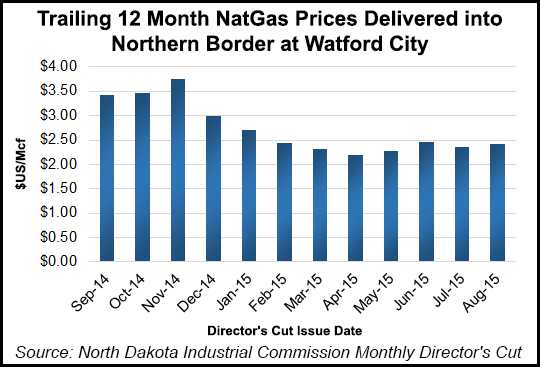Bakken Shale | E&P | NGI All News Access
Research Seeks to Extract More Value From Various Gas Streams
The University of North Dakota’s (UND) energy research unit said it has a small part of a larger, $3.5 million research project involving industry, university and federal government researchers who are seeking to develop a process for extracting more value out of gas streams, including natural gas.

UND’s Energy and Environmental Research Center (EERC) officials said that indirectly the research could lead to helping deal with the increasing volumes of gas produced as a byproduct of North Dakota’s plentiful Bakken sweet crude oil, although they caution that reaching that outcome is still a long way down the road.
For now, the researchers are focused on unlocking an electrochemical cell that will convert natural gas or methane to methanol, which is ten times more valuable and versatile in the global market. This is “very tough fundamental research at a lab scale,” said EERC Assistant Director Chris Zygarlicke, who added that there are no current fuel cells that can operate on a variety of fuel sources, so making this breakthrough would be big “on a variety of technical realms.”
EERC has partnered with Connecticut-based FuelCell Energy Inc., an integrated stationary fuel cell manufacturer, to develop a “durable, low-cost and high-performance electrochemical cell,” or nickel (Ni)-alloy/ceria-based anode to do the natural gas conversions. Methanol, they said, has worldwide applications in the production of liquid fuels, solvents, resins and polymers.
However, experts are saying that it could be a long road back for deflated methanol prices, and recent declines in oil and oil-linked commodities, and overall global economic headwinds are likely to continue to pressure methanol prices in the near term, according to Fitch Ratings (see Daily GPI, Aug. 28).
If methanol prices are to make a comeback, they will need gradually rising energy prices, along with growth in methanol used for energy applications, such as fuel blending, and methanol-to-olefins processes, which use methanol as a feedstock to make chemical derivatives such as propylene and ethylene, the Fitch analysis said.
FuelCell Energy has assembled a team for the project that includes scientists and engineers from the Pacific Northwest National Laboratory, University of Connecticut, and Massachusetts Institute of Technology. They have a $3.5 million grant from the U.S. Department of Energy’s (DOE) Advanced Research Projects Agency (ARPA-E) which is searching for “entirely new ways to generate, store and use energy,” according to an EERC spokesperson.
EERC’s part of the project is being funded through matching funds from the North Dakota Department of Commerce’s “Research ND” program, and the grant to EERC was its first Research ND stipend. EERC and UND have some experts in electrochemistry, a large field of engineering research in industry and federal research circles right now, the EERC spokesperson said.
“Fuel cells mostly operate on methane streams and some on liquid methanol,” Zygarlicke said. “If this fundamental research proves successful, eventual applications could utilize any available methane or hydrogen stream: landfill gas, natural gas, syngas, anaerobic digester gas, hydrogen and gas associated with oil/gas production, such as flared gas.”
The ultimate goal is to eventually have a system that could convert all sorts of methane streams, including perhaps natural gas from oil/gas production, but that would be an eventual [not near-term] application,” Zygarlicke told NGI‘s Shale Daily.
EERC Director Tom Erickson said the ongoing research is a good example of “leveraging private sector dollars with state research funds on a technology that could greatly impact North Dakota’s economy.” If they can find the key, Erickson said it could eventually work to produce value-added products from both fossil and renewable methane.
The long-term vision shared by the EERC researchers is the potential to develop a “modular, efficient and cost-effective” solution that could be developed in both large-scale industrial plants and for smaller scales in which natural gas is available in smaller quantities.
Eventually, they are seeking to monetize all of the value of natural gas in a smaller-scale plant. There is the potential for applying the technology to methane-rich landfill and wellhead flared gas supplies, soaking up some of the methane emissions now under the scope of federal regulators. Zygarlicke said at this early stage there is no “black box” that will emerge from this research that could be used at the wellhead in the Bakken.
© 2024 Natural Gas Intelligence. All rights reserved.
ISSN © 2577-9877 | ISSN © 2158-8023 |
